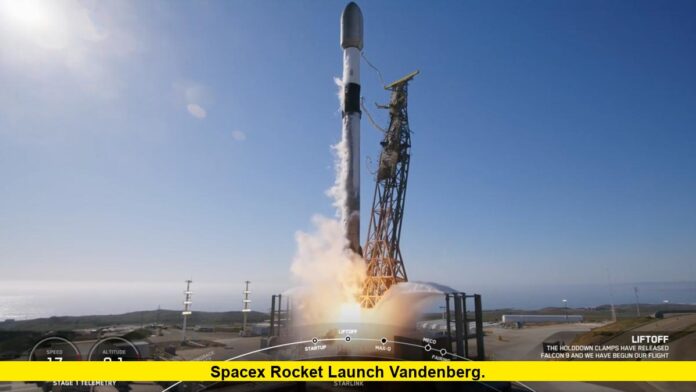SpaceX rocket launch Vandenberg drew global attention late on July 26, 2025, as a Falcon 9 successfully carried 24 Starlink satellites into low Earth orbit. Liftoff took place at 9:31p.m. PDT from Space Launch Complex 4E at Vandenberg Space Force Base in California. This launch further expands Starlink’s role in providing high-speed internet access around the globe.
Command centers, spectators, and online viewers alike watched as the veteran Falcon 9 booster—making its 19th flight—left the California coast. Shortly after stage separation, the first stage executed a textbook landing on the drone ship “Of Course I Still Love You” stationed in the Pacific Ocean, marking another milestone in SpaceX’s push for rapid rocket reusability.
Starlink Group 17-2: Launch Details
The mission, dubbed Starlink Group 17-2, delivered 24 next-generation Starlink v2 Mini satellites to polar orbit. These satellites are part of SpaceX’s ever-expanding low Earth orbit constellation, which already boasts over 8,000 active units and aims for a total deployment exceeding 12,000 in the next few years. With Starlink, SpaceX is working to bridge connectivity gaps—particularly in rural and underserved regions.
Key technical details:
- Launch site: Space Launch Complex 4E, Vandenberg SFB, California
- Liftoff time: 9:31p.m. PDT, July 26 (04:31 UTC, July 27)
- Rocket: Falcon 9 Block 5
- Booster: B1075 (19th flight, 64-day turnaround)
- Drone ship landing success: “Of Course I Still Love You”
- Payload: 24 Starlink v2 Mini satellites
- Destination: Low Earth Orbit (polar inclination)
- Mission type: Communications
Why Vandenberg?
Vandenberg Space Force Base is a key site for SpaceX, enabling launches into polar orbits that are optimal for global coverage, especially as the Starlink network aims to support customers worldwide. The Southern California location also helps SpaceX coordinate back-to-back missions, with this Starlink launch coming less than 24 hours after another Starlink mission from Florida.
Reusability Milestones
The first stage booster used on this mission has a storied history, supporting 18 previous flights, including missions for the U.S. Space Force and several prior Starlink payloads. Rapid refurbishment and return-to-flight capabilities—only 64 days between consecutive launches—highlight SpaceX’s efficiency gains and cost savings compared to traditional expendable rockets.
Falcon 9 Booster Stats Table:
Spectacular Night Launch and Public Engagement
Thousands tuned in to live streams and social platforms for real-time coverage, with launch windows stretching from 9:31p.m. to 10:00p.m. PDT. Spectators across the California coast witnessed the bright arc of Falcon 9 cutting through the night sky, with social media buzzing about the launch’s precision and visual spectacle.
Impact and What’s Next
This launch comes during a record-setting year for SpaceX: more than 91 missions have already flown, supporting Starlink expansion, commercial customers, and scientific research. The next several months promise additional launches from both Vandenberg and Cape Canaveral, as SpaceX pushes for bolder achievements, including work on its Starship and human spaceflight programs.
SpaceX has already published backup opportunities for launches from Vandenberg in late July and early August, signaling a relentless pace to grow the Starlink network and demonstrate Falcon 9’s reliability. Each successful launch brings high-speed internet closer to unconnected areas, reshaping digital access on a planetary scale.
Incredible feats like the SpaceX rocket launch Vandenberg continue to inspire and drive innovation. What did you think of last night’s mission? Share your thoughts or questions in the comments and stay tuned for more stellar updates!
